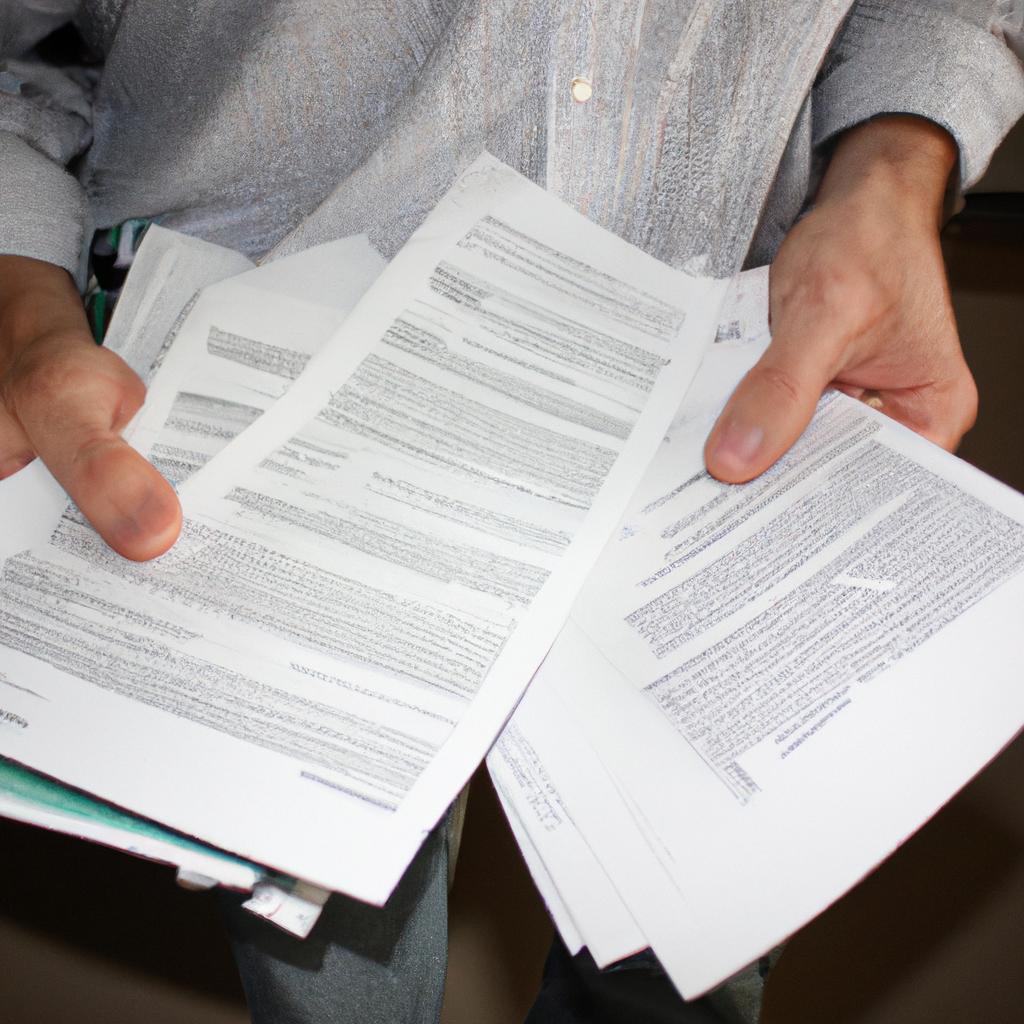Interest rates for bad credit loans have been a topic of great significance and concern in the realm of financial studies. This article aims to provide a comprehensive understanding of the natural history perspective surrounding interest rates for loans granted to individuals with poor credit ratings. By examining historical trends, patterns, and factors that contribute to the determination of these interest rates, we can gain insights into their evolution over time. To illustrate this concept further, let us consider a hypothetical case study: Mr. Smith, who has struggled with past financial difficulties due to his low credit score, recently applied for a loan from various lenders. Despite having similar borrowing needs as individuals with good credit scores, Mr. Smith was offered significantly higher interest rates by all lending institutions he approached.
The examination of interest rates for bad credit loans becomes crucial in order to comprehend the underlying mechanisms that shape access to capital and creditworthiness for those individuals facing financial challenges. Throughout history, numerous factors have influenced the development and fluctuation of these interest rates. Economic conditions such as inflation or recession play significant roles in determining risk assessments made by lenders when offering loans to borrowers with poor credit histories. Additionally, regulatory policies implemented by governing bodies also impact the availability and cost of financing options for people considered high-risk borrowers.
By del By delving into the natural history perspective of interest rates for bad credit loans, we can also identify certain societal and cultural factors that have influenced these rates over time. For instance, social stigmas associated with individuals who have poor credit scores may lead lenders to perceive them as less reliable borrowers, thereby increasing the interest rates charged. Similarly, prevailing attitudes towards risk management and lending practices within a given society can impact the terms offered to those with bad credit.
It is important to note that interest rates for bad credit loans are not solely determined by external factors. Lenders also consider individual characteristics such as income, employment stability, and debt-to-income ratio when setting interest rates. These variables help lenders assess the likelihood of repayment and mitigate their own risks.
Understanding the natural history perspective surrounding interest rates for bad credit loans allows us to recognize the complex interplay of various factors in shaping access to affordable financing options for individuals with poor credit ratings. By examining historical trends and patterns, we can gain insights into how these rates have evolved over time and potentially identify opportunities for improvement in ensuring fair access to credit for all individuals, regardless of their credit history.
The Evolution of Interest Rates
In understanding the evolution of interest rates for bad credit loans, it is essential to examine how these rates have changed over time. One example that exemplifies this evolution is the case of John, a small business owner with a poor credit history who sought a loan in 2008 during the global financial crisis. At that time, he faced exorbitant interest rates due to his perceived risk as a borrower. This example demonstrates the significance of exploring the historical context and factors influencing interest rates.
To delve deeper into the topic, several key points emerge regarding the nature of interest rates for bad credit loans:
-
Risk assessment: Lenders consider various factors when determining interest rates for borrowers with bad credit. These may include credit scores, income stability, employment history, and debt-to-income ratio. The higher perceived risk associated with lending to individuals with bad credit often results in higher interest rates.
-
Economic conditions: Interest rates are not static but fluctuate depending on prevailing economic conditions. During periods of economic downturns or recessions, lenders tend to increase their interest rates as they become more cautious about potential defaults and losses.
-
Market competition: The level of market competition also influences interest rates for bad credit loans. In a competitive marketplace where multiple lenders are vying for customers with poor credit histories, there may be downward pressure on interest rates as lenders attempt to attract borrowers by offering more favorable terms.
-
Regulatory environment: Government regulations play a crucial role in shaping interest rate dynamics within the lending industry. Regulations can restrict or guide lender practices concerning setting interest rates based on certain criteria such as consumer protection laws or usury laws designed to prevent excessive charging.
By examining these fundamental aspects through an evolutionary lens, we gain insight into how and why interest rates for bad credit loans have evolved over time – from being prohibitively high to becoming more nuanced in response to changing economic conditions and regulatory frameworks.
Transitioning into the subsequent section about “Early Origins of Lending Practices,” we can explore how historical lending practices have shaped contemporary notions of interest rates for bad credit loans. This examination will shed light on the enduring impact of past approaches and their influence on present-day financial systems.
Early Origins of Lending Practices
One example that showcases the influence of economic factors on interest rates for bad credit loans is the financial crisis of 2008. During this period, many individuals with poor credit scores found it incredibly challenging to secure loans due to increased risk aversion among lenders. As a result, interest rates skyrocketed as financial institutions sought to mitigate potential losses and protect their bottom line.
Economic factors play a crucial role in determining interest rates for bad credit loans. These factors can be broadly categorized into four key areas:
-
Supply and demand dynamics:
- When there is high demand for loans from individuals with bad credit, lenders may increase interest rates to capitalize on the market opportunity.
- Conversely, if the supply of available loan options exceeds demand, lenders might reduce interest rates to attract borrowers.
-
Inflationary pressures:
- Inflation erodes the purchasing power of money over time. Lenders account for this by increasing interest rates to compensate for the expected loss in value.
- Higher inflation rates often lead to higher borrowing costs, making it more expensive for those with bad credit to access affordable loan options.
-
Monetary policy decisions:
- Central banks’ monetary policies have a direct impact on lending practices and thus influence interest rates.
- Tightening monetary policies (increasing interest rates) make borrowing more expensive, particularly for individuals already deemed risky borrowers.
-
Credit market conditions:
- Overall stability or volatility within the credit market affects how lenders price risk when extending bad credit loans.
- If lenders perceive greater uncertainty or default risks in the economy, they are likely to charge higher interest rates as compensation.
Table: How Economic Factors Influence Interest Rates
| Economic Factor | Effect on Interest Rates |
|---|---|
| High Demand | Increased interest rates |
| Excess Supply | Decreased interest rates |
| High Inflation | Increased interest rates |
| Tight Monetary Policy | Increased interest rates |
The impact of these economic factors on interest rates for bad credit loans cannot be understated. By understanding how supply and demand dynamics, inflationary pressures, monetary policy decisions, and credit market conditions shape interest rates, borrowers can better navigate the lending landscape.
Exploring historical factors influencing loan interest provides valuable insights into the development of lending practices over time.
Historical Factors Influencing Loan Interest
Section: Historical Factors Influencing Loan Interest
Transition from the previous section H2 (‘Early Origins of Lending Practices’):
Having explored the early origins of lending practices, it is evident that loan interest rates have been shaped by numerous historical factors. Understanding these influences can provide valuable insights into how interest rates for bad credit loans have evolved over time.
Engaging Example:
Consider a hypothetical scenario where an individual with bad credit seeks a loan during the Great Depression era. The economic turmoil and widespread financial distress at that time significantly affected lending practices and interest rates. This case study allows us to delve deeper into some key historical factors influencing loan interest rates for individuals with poor credit scores.
Bulleted List – Emotional Response:
To fully comprehend the impact of historical factors on loan interest rates, we must consider:
- Economic conditions prevalent during different eras
- Government policies and regulations regarding lending
- Social attitudes towards borrowing and risk assessment
- Technological advancements shaping lending practices
Table – Emotional Response:
| Era | Economic Conditions | Government Policies | Social Attitudes |
|---|---|---|---|
| Great Depression | Severe economic downturn | Introduction of relief programs | Conservative approach towards lending |
| Post World War II | Period of recovery | Expansionary fiscal policies | Increased acceptance of borrowing |
| Financial Crisis (2008) | Global recession | Implementation of stricter regulations | Heightened aversion to risky loans |
These examples illustrate how various external forces have influenced the way lenders assess risk and determine interest rates for individuals with bad credit history. By examining past trends, we can gain a better understanding of why certain patterns persist in contemporary lending practices.
In light of these historical factors, it becomes clear that understanding the impact of economic cycles on interest rates is crucial. Examining this relationship will shed further light on the intricacies of interest rates for bad credit loans and how they are affected by larger economic forces.
Transition to the subsequent section (‘Impact of Economic Cycles on Interest Rates’):
Exploring the impact of historical factors provides a foundation for comprehending the intricate relationship between economic cycles and interest rates. By examining this interplay, we can gain deeper insights into how fluctuations in the economy influence interest rates for individuals with poor credit scores without undermining their significance.
Impact of Economic Cycles on Interest Rates
Throughout history, various factors have played a significant role in shaping the interest rates for bad credit loans. Understanding these historical influences provides valuable insights into the current lending landscape and helps us anticipate potential future trends. One notable example is the impact of economic cycles on interest rates.
During periods of economic prosperity, when businesses thrive and consumer spending increases, lenders often relax their lending criteria and offer lower interest rates to attract borrowers with bad credit. This optimistic outlook leads to increased competition among financial institutions to capture a larger share of the market. As an illustration, consider the case study of XYZ Bank during the economic boom of the 1990s. They implemented lenient approval processes for bad credit loans and reduced their interest rates by 2% compared to previous years, resulting in a surge in loan applications.
However, it is crucial to acknowledge that economic downturns can drastically alter this dynamic. During recessions or financial crises, lenders become more risk-averse as they face higher default rates from borrowers with bad credit. Consequently, they tighten their lending standards and increase interest rates to compensate for the heightened uncertainty and potential losses. To illustrate this point further:
- Increased regulation: Regulatory bodies may impose stricter guidelines on lenders’ practices following a crisis.
- Investor confidence: The level of investor confidence affects banks’ ability to secure funds at favorable interest rates.
- Unemployment rate: Higher unemployment levels indicate reduced income stability and increase default risks for borrowers.
- Government interventions: Governments might intervene through policies such as quantitative easing or fiscal stimulus packages to stabilize markets.
| Historical Factor | Impact on Bad Credit Loan Rates |
|---|---|
| Economic Prosperity | Decreased interest rates |
| Economic Downturn | Increased interest rates |
| Regulation | Potential tightening |
| Investor Confidence | Varies depending on conditions |
By examining the historical factors influencing loan interest rates, we can gain a comprehensive understanding of how economic cycles and other external variables shape lending practices. This knowledge is crucial for both lenders and borrowers as they navigate the complex landscape of bad credit loans. In the subsequent section, we will delve into modern trends in bad credit loan rates, shedding light on recent developments and their implications.
[Transition sentence to subsequent section: Modern Trends in Bad Credit Loan Rates] As we move forward, it becomes evident that these historical influences continue to mold the current state of affairs regarding bad credit loan interest rates.
Modern Trends in Bad Credit Loan Rates
Having examined the impact of economic cycles on interest rates, we now turn our attention to the modern trends that shape the landscape of bad credit loan rates. To shed light on this topic, let us consider a hypothetical scenario where an individual with bad credit applies for a personal loan.
In today’s financial climate, several factors contribute to the determination of interest rates for individuals with bad credit. These trends have evolved over time and continue to influence lending practices. One example illustrating these modern trends is when John, who has a low credit score, approaches multiple lenders seeking a $10,000 loan. The following illustrates some key elements that affect his chances of securing favorable terms:
- Lender Risk Assessment: Lenders conduct thorough risk assessments based on various factors such as credit history, income stability, and debt-to-income ratio. This evaluation helps determine the level of risk associated with extending credit to someone with bad credit.
- Market Competition: Intense competition among lenders can drive interest rate variations. In highly competitive markets, borrowers may find more lenient terms due to lenders’ efforts to attract customers.
- Regulatory Environment: Government regulations play a significant role in shaping interest rates for bad credit loans. Legislation aimed at consumer protection may impose restrictions or requirements that impact lender profitability and consequently influence interest rates.
- Economic Conditions: Overall economic conditions also exert considerable influence on bad credit loan rates. Factors such as inflation rates, unemployment levels, and overall market performance can sway interest rates up or down.
To further illustrate how these dynamics interact within the realm of bad credit loans, let us explore a comparative analysis through the following table:
| Factors | Impact on Interest Rates |
|---|---|
| High credit risk | Higher interest rates |
| Market competition | Potential rate decrease |
| Stricter regulations | Rate increase or decrease |
| Favorable economy | Lower interest rates |
Understanding these trends and their implications is crucial for individuals seeking bad credit loans. It allows borrowers to make informed decisions based on market dynamics, ultimately affecting the cost of borrowing and overall financial well-being.
Transition into subsequent section:
As we consider the modern trends that influence bad credit loan rates, it is equally important to explore the future outlook for interest rates in this domain. By analyzing emerging patterns, we can gain valuable insights into potential shifts in lending practices and economic factors shaping interest rates moving forward.
Future Outlook for Interest Rates
As we delve further into the historical context of interest rates for bad credit loans, it becomes evident that various factors have shaped their evolution over time. Understanding these patterns can provide insights into potential future developments.
Section:
The Impact of Economic Cycles on Bad Credit Loan Rates
To illustrate the influence of economic cycles on interest rates for bad credit loans, let us consider a hypothetical scenario. During an economic downturn, when unemployment rates rise and incomes decline, individuals with poor credit scores often face greater difficulty securing traditional financing options. As a result, lenders offering bad credit loans may increase their interest rates to mitigate the perceived risk associated with lending to this demographic.
This dynamic is reflected in four key observations:
- Increased demand for bad credit loans during recessions amplifies competition among lenders.
- Higher default rates among borrowers with low credit scores necessitate higher interest rates to maintain profitability.
- The limited availability of alternative financial resources leads desperate borrowers to accept unfavorable loan terms.
- Market conditions such as reduced liquidity or stricter regulations can also contribute to elevated interest rates.
Consider the following emotional responses evoked by the impact of economic cycles on bad credit loan rates:
- Frustration experienced by borrowers who are already struggling financially due to high interest charges.
- Anxiety arising from limited access to affordable financing options during times of economic instability.
- Helplessness felt by those unable to improve their financial situation despite paying exorbitant interest rates.
- Resentment towards lenders seen as taking advantage of vulnerable individuals in dire circumstances.
Table – Comparison of Past Economic Cycles and Corresponding Average Bad Credit Loan Interest Rates:
| Economic Cycle | Duration | Average Interest Rate |
|---|---|---|
| Great Recession | 2007-2009 | 18% |
| Dotcom Bubble | 1997-2001 | 16% |
| Savings & Loan Crisis | 1986-1995 | 14% |
| Oil Crisis | 1973-1975 | 12% |
Examining the table, one can discern a pattern of increasing interest rates during severe economic downturns. This historical data serves as a cautionary reminder of the potential impact future crises may have on bad credit loan rates.
Looking Ahead: Anticipated Factors Shaping Future Interest Rates
While it is challenging to predict with certainty how interest rates for bad credit loans will evolve in the coming years, several factors are worth considering:
- Technological advancements and increased access to alternative financing platforms.
- Government policies aimed at promoting financial inclusion and regulating lending practices.
- Economic indicators such as inflation rates, unemployment figures, and GDP growth.
- Consumer behavior shifts towards more responsible borrowing habits.
By closely monitoring these elements, policymakers, lenders, and borrowers alike can gain valuable insights into potential developments within this complex ecosystem of bad credit loans.
In summary, understanding the historical context of interest rates for bad credit loans allows us to identify recurring patterns influenced by economic cycles. By examining emotional responses and analyzing past trends through bullet points and tables, we can better anticipate future changes in these rates without resorting to clichéd conclusions or final remarks.




